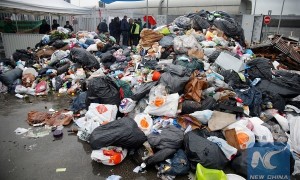导读:本年度第二季度中,电子商务和分享型经济为中国的中西部城市和三线城市带来了更多的就业机会。

Job opportunities grew during the second quarter in the central and western part of China and in third-tier cities, thanks to e-commerce and the sharing economy.
本年度第二季度中,电子商务和分享型经济为中国的中西部城市和三线城市带来了更多的就业机会。
Chinese job recruitment website Zhaopin and the China Institute for Employment Research jointly released their second quarter employment report recently. The report showed that first-tier cities, as well as the country’s eastern region generally, continued to generate the majority of new job opportunities. Eastern China generated 73 percent of them.
近期,中国的求职应聘网站“智联招聘”及中国就业研究所联合发布了第二季度的就业报告。报告显示,73%的工作机会都源于中国东部,一线城市及东部城市继续担任创造新就业机会的主力军。
Yet the employment situation in the less-developed middle and western regions of China had improved, compared with the same period last year. New jobs in Central China grew at the fastest rate, reaching 29 percent of the total. Western China was next, with 23 percent.
然而与去年同期相比,中国中西部欠发达地区的就业形势也有所好转。中部地区提供了29%的就业机会,涨幅最大。提供23%就业机会的西部地区紧随其后。
Third-tier cities and other less-developed areas, despite having relatively low numbers, saw 27 percent growth in new job openings compared with same period last year.
尽管三线城市和其它欠发达地区的涨幅相对较小,但与去年同期相比,这些地区就业机会增长高达27%。
Zeng Xiangquan, director of the China Institute for Employment Research, said the overall employment situation in the second quarter had improved from the first quarter. The index-the proportion of job vacancies for each job seeker-increased from 1.71 to 1.93.
中国就业研究所所长曾湘泉表示,第二季度的就业形势总体上较第一季度有很大改善。单个求职者的岗位空缺比例指数从1.71上升至1.93。
"In the second half of the year, we could still see a drop in the index. The competition in job market could become fiercer," said Zeng. "However, the overall picture is stabilizing."
曾所长称,“下半年,指数可能会下降。就业市场的竞争将更加激烈。然而,总体就业情况正趋于稳定。”
Guo Sheng, CEO of Zhaopin, said the biggest problem underlying the job pressure in China is the mismatch between employers and job seekers.
智联招聘公司执行总裁郭盛称,当前隐藏在中国就业压力下的最大问题是求职者和企业需求之间的不匹配。
"The reasons behind the mismatch are complicated," Guo said. "We see job opportunities cluster in regions that are not provinces with large populations. Labor mobility is not enough to meet this demand. Besides, many job seekers continue to look for opportunities in traditional industries that are cutting positions."
郭盛称,“原因很复杂。就业机会多的地区人口并不多。劳动力流动不足以满足这个需求。此外,很多求职者更愿意在传统产业求职,而这些产业却正在削减职位。”
For example, in the internet industry about 11 job vacancies had only one applicant, while in the mining industry, about 100 job seekers competed for 24 jobs.
比如,互联网产业有11个岗位空缺,但申请人只有一个,而只有24个空缺岗位的采矿工业却有100个人在申请。
One solution to the structural unbalance is the sharing economy and e-commerce, Guo said.
郭盛说,分享型经济和电子商务就是解决这种结构不平衡的方法。
According to Didi Dache, the car-hailing platform, it has provided 3.89 million job opportunities in 17 provinces that are cutting industrial overcapacity and jobs.
滴滴打车这款打车平台软件为17个省提供了389万个就业机会,这些省份正因产业过剩而削减职位。
The Ministry of Human Resources and Social Security said an estimated 1.8 million employees in the iron and coal industry will be laid off in the process of reducing excess industrial capacity in China.
人力资源和社会保障部部长认为,中国正缩减产能过剩的产业,预计钢铁产业和煤炭工业的下岗人数将达到180万。







